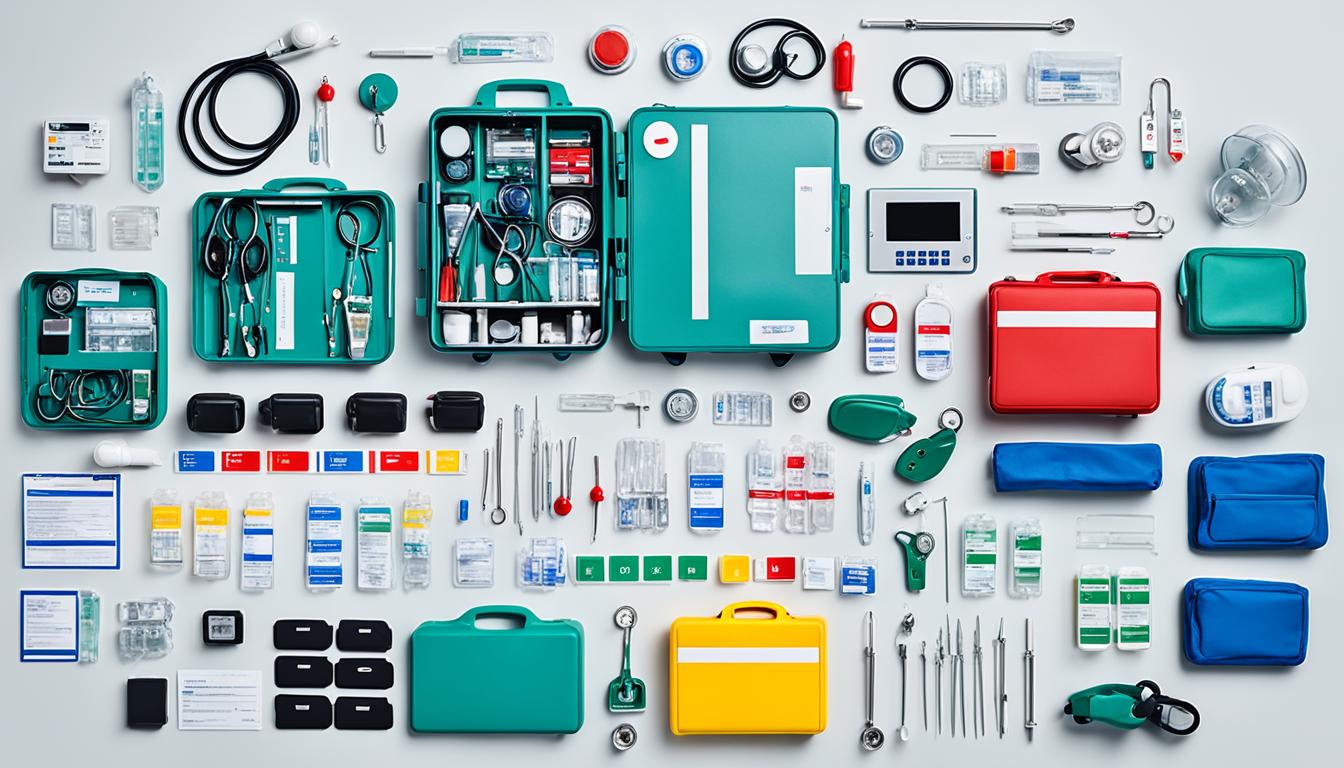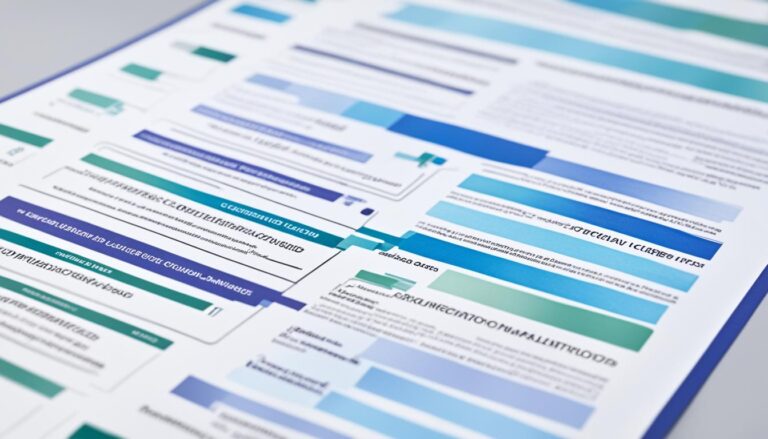Understanding EMS Regulations in the US
Every year, about 240 million calls are made to 9-1-1 in the US. Many lead to quick and effective help from Emergency Medical Services (EMS). There’s a whole system of EMS regulations behind each life-saving action. These rules, including EMT and ambulance service guidelines, are vital for emergency care.
EMS regulations show our dedication to health and safety. They adapt to the changing medical transport rules. Whether in New York City or Alaska, these rules ensure protection for both the people in need and the EMS professionals.
EMS guidelines cover everything from how ambulances should operate to the best emergency care practices. We will explain the key EMS rules and why they matter. This information is critical for anyone involved in providing urgent medical care.
Key Takeaways
- The necessity of understanding EMS regulations to ensure compliance and quality care.
- The vast number of emergency calls in the US that EMS regulations help to manage effectively.
- A look at the diversity of emergency medical service laws across different states and regions.
- The critical role of ambulance regulations in maintaining the safety and readiness of medical transport.
- An introduction to EMS compliance requirements that every EMT and paramedic must follow.
- Insight into the federal and state oversight which shapes the guidelines and practices of EMS providers.
Overview of US Emergency Medical Services
The US emergency medical services have a rich history. It began with committed professionals and volunteers. They aimed to save lives and offer medical care during crises.
The Foundation and Evolution of EMS
The EMS evolution marks a shift from basic community help to a professional service network. EMS changed from horse-drawn ambulances to advanced fleets. This change was driven by need and new ideas.
Federal Agencies and EMS Oversight
Federal agencies play a big role in EMS. They regulate and improve EMS through funds and policies. They set protocols that shape today’s EMS work.
Diversity of EMS Systems Across States
EMS systems differ across the US. This shows the unique needs and rules of each state. While missions are the same, the way services are given depends on the state’s needs.
The US emergency medical services are always improving. They adapt but keep their main goal. That’s to provide urgent care when it’s most critical.
Emergency Medical Services (EMS) Regulations
Following EMS regulations is crucial for high-quality emergency medical care in the U.S. These rules cover many areas, asking providers to follow strict protocols. This ensures patients get safe, reliable care.
One key area is licensing for emergency medical services regulations. Providers must navigate various rules to ensure their team is properly trained and credentialed. Training is also important, keeping EMS teams up-to-date on medical procedures and equipment, helping save lives in emergencies.
- Licensing for EMS personnel and services
- Ongoing educational programs and certification
- Equipment checks and maintenance protocols
- Operational policies adhering to health and safety guidelines
- Inter-agency communication and operational coordination
Equipment rules are also crucial in EMS. To follow EMS regulations, all gear and vehicles must meet specific standards. This ensures they work correctly in emergencies, maintaining a commitment to readiness and reliability despite new technology.
Other key compliance areas affect EMS daily operations. These include recording data, protecting patient privacy, and managing hazardous materials. Meeting these complex rules is tough but essential for an effective, trusted EMS system.
Not complying can result in fines or losing licenses. Regular audits and checks are important. Compliance builds community trust and ensures the EMS system stays ready and reliable, providing top care as health needs and emergencies change.
Federal Influence on EMS Development
The growth of Emergency Medical Services (EMS) in the US is deeply linked to federal actions. This includes laws, money, and common standards. Understanding this influence shows how EMS has evolved to face public health needs.
NHTSA’s Role in Shaping EMS Practices
The National Highway Traffic Safety Administration (NHTSA) leads in shaping EMS. They write safety rules and make training materials for EMS workers. Thanks to NHTSA, care is uniform everywhere, meaning everyone gets high-quality treatment.
NHTSA also tackles data issues, giving EMS the tools to get better at what they do. This helps them measure their success and make needed improvements.
Significance of the EMSS Act
The EMS Systems Act (EMSS Act) was a game-changer for EMS. It led to better emergency systems, letting areas work together more. The EMSS Act gave funds to start EMS setups that are crucial even now. Its effects keep helping EMS grow.
Shift from Federal to State EMS Funding
How EMS is funded has changed, moving from federal to state EMS funding. This change lets states decide how to spend money, aiming to meet local needs better. Yet, it can be hard for states with less money. This might make EMS care vary place to place.
The Federal influence on EMS has set high standards in how EMS works. It keeps shaping today’s EMS, even as funding sources change. This calls for creative thinking to keep up the quality without losing what has been gained.
Funding Models for EMS
New trends and law changes are affecting EMS funding models a lot. This shows how key it is to have many ways to get money for vital medical help. We’re going to look at how funding from federal, state, and local levels works together in EMS.
Federal Funding and Grants
Federal funding and grants are crucial for EMS funding models. They help EMS providers get what they need to keep going, train staff, and buy new lifesaving tools. Getting federal money is often key to how well EMS can serve their community, linking money to the care people get.
The Role of CMS in EMS Reimbursement
The CMS role in EMS reimbursement is vital too. CMS rules control how EMS charges and gets paid back. This is not just to follow rules. It’s also so EMS providers get paid on time for their work, keeping their important services going.
Local Government Contributions and Challenges
Local government’s help for EMS shows how much a place cares about health help. But, it’s not easy. Money issues and changing economies can change how much money EMS gets. This can make it hard to decide how to use the limited money for EMS.
| Funding Source | Description | Challenges |
|---|---|---|
| Federal Funding and Grants | Allocations directed towards EMS via federal agencies and grant programs | Potentially inconsistent and dependent on changing political priorities |
| CMS Reimbursement | Payments received from CMS for services rendered to Medicare and Medicaid beneficiaries | Navigating complex reimbursement structures and requirements |
| Local Government Contributions | Funding from city or county budgets specifically earmarked for EMS | Varied based on local fiscal health; may not adequately cover operational costs |
Regulatory Framework for EMS Providers
The EMS regulatory framework in the United States plays a crucial role in our healthcare system. It makes sure that emergency medical services (EMS) providers meet top standards of patient care and safety. Key parts of this framework include tough licensing requirements for EMTs, detailed training requirements for EMTs, strict protection of patient info through HIPAA, and OSHA’s safety measures for the workforce. Now, let’s look at what rules EMS providers follow at different levels.
Licensing and Training Requirements for EMTs
EMTs are the first ones to respond when we face medical emergencies. They must fulfill intense training requirements to get licensed. Each state decides its own rules, but they all follow national standards. This includes finishing an approved program and passing exams. EMTs also need ongoing education to keep up with new medical practices.
Impact of HIPAA on EMS Operations
When HIPAA started, it changed how EMS providers manage patient information. The HIPAA impact on EMS operations involves important areas like patient privacy, data security, and confidentiality. EMS providers have to follow strict privacy rules. If they don’t, they could face severe penalties. This shows how serious HIPAA is about keeping healthcare responsible.
OSHA’s Role in EMS Workforce Safety
The Occupational Safety and Health Administration (OSHA) looks after workforce safety in the EMS field. It makes sure EMTs have a safe workplace by enforcing safety standards. Thanks to OSHA’s role in EMS workforce safety, EMTs can do their vital work safely. This is key to keeping the EMS workforce strong and ready to help.
Legislation Impacting EMS Services
The complex world of EMS legislation in the United States features various laws. These laws affect emergency medical services every day. Understanding these legislation impacting EMS services is important for following the rules and delivering good care to communities. We will look at the key legislative acts that shape EMS services today.
A few important acts have greatly influenced EMS systems and how they work. These EMS laws standardize practices, help get funding, and make sure emergency care keeps up with demands and new technologies.
“EMS legislation should be adaptive to the progressive aspects of medical services, while safeguarding the interest of the public and the responders alike.”
Apart from federal rules, state and local governments have their own EMS laws. These laws meet the specific needs and resources of each region. This creates a mix of rules that healthcare providers need to understand and follow.
| Legislative Act | Impact on EMS Services |
|---|---|
| Emergency Medical Treatment and Active Labor Act (EMTALA) | Ensures public access to emergency services irrespective of their ability to pay. |
| American Ambulance Association (AAA) | Advocates for legislation that promotes innovation and effective emergency response. |
| Protecting Patient Access to Emergency Medications Act | Safeguards the administration of controlled substances in emergency situations. |
| Pandemic and All-Hazards Preparedness Reauthorization Act (PAHPRA) | Enhances the nation’s public health and medical preparedness and response capabilities for emergencies, including pandemics. |
This group of laws focuses on delivering the best patient care and keeping EMS personnel safe. They give a legal structure for EMS operations. They also often affect how much money goes to important EMS services.
- Following these laws doesn’t just keep things legal; it’s key to earning public trust and quality emergency response.
- Staying up-to-date with EMS laws and regulations is a big part of EMS work.
- New laws should tackle new issues like digital security in healthcare and using telemedicine before hospital care.
In conclusion, EMS legislation constantly evolves with the fast-paced world of healthcare. Staying alert and flexible is essential. This helps balance innovation with the core values of emergency medical services.
Compliance Requirements for Ambulance Services
Ambulance services must understand complex rules to provide safe and reliable care. These rules protect patients and medical staff in emergencies. They must follow strict guidelines on staff and equipment, control medications as per DEA, and adhere to CLIA for lab services.
Mandatory Staffing and Equipment Standards
Ambulance services need to follow firm staffing standards for ambulances. They must have qualified EMTs and paramedics ready for every emergency. They also have to ensure their ambulances have the necessary equipment standards for ambulances. Every vehicle should have vital medical supplies, which are checked and updated regularly.
The DEA’s Control Over EMS Medications
The DEA has strict rules on EMS medications. Emergency services must keep accurate records, secure the drugs properly, and dispose of them correctly. These steps help prevent misuse and ensure medications are ready when needed.
CLIA and Laboratory Services in Ambulances
Laboratory services are becoming vital in emergency care outside the hospital. The CLIA regulation for laboratory services in ambulances ensures tests are accurate and reliable. It sets the standards for tests that can be done, who can do them, and how equipment should be maintained.
| Regulation Category | Key Requirements | Responsible Party |
|---|---|---|
| Staffing Standards | Certified EMTs, Adequate Team Size | EMS Providers |
| Equipment Standards | Medical Devices, Supplies, Vehicle Upkeep | Ambulance Services |
| Controlled Medications | Secure Storage, Proper Documentation | DEA & EMS Providers |
| CLIA Lab Services | Qualified Personnel, Valid Test Results | Healthcare Entities |
Emergency Medical Services for Children
It’s vital that our kids get fast and right emergency medical care when they need it. The world of children’s emergency services has grown, thanks to federal efforts. The EMSC program leads these efforts, making sure kids across the nation get the care they need.
EMSC Program Details and Objectives
The Emergency Medical Services for Children (EMSC) program plays a key role in refining care for young patients. It boosts state efforts to improve training, gear, and procedures for treating kids in emergencies. Its main goal? To make sure kids everywhere can get top-notch emergency care suited to their needs.
PECARN: Advancing Pediatric Emergency Research
Research is key to getting better at caring for kids in emergencies. The PECARN leads the way in this research. It works on studies that help us know more, improving how we treat kids. This sets high standards for research in children’s emergency care.
Federal Initiatives to Enhance Pediatric Care
Federal projects aim to raise the bar for children’s emergency services. They cover many programs and policies. Their goal is to improve how we respond to children in emergencies now and plan for better care in the future. It shows a strong dedication to keeping our kids safe and healthy in emergencies.
| Initiative | Objective | Impact |
|---|---|---|
| EMSC Program | Improve pediatric EMS capabilities at all levels | Enhanced outcomes and reduced mortality rates for pediatric emergencies |
| PECARN | Drive pediatric-specific emergency research | Advanced scientific evidence for informed decision-making in pediatric care |
| Federal Pediatric Policies | Implement standards and protocols designed for children | Consistent and equitable access to quality emergency care for all children |
The Importance of Data in Shaping EMS Policies
The importance of data in EMS policies is huge in today’s changing medical world. The rise of data-driven EMS policies has changed how emergency services work. They now use facts to make changes and new policies. By looking closely at EMS data analysis, key players can spot trends. These can impact how services are delivered and how patients are cared for.
Using data in EMS helps check if current ways are working well. This leads to constant betterment in this area. For instance, looking at how fast EMS responds and patients’ results can show where changes are needed. Data on how resources are used makes sure EMS teams have what they need for their areas.
Also, collecting lots of data, especially during big crises, gives key insights. These help make EMS protocols stronger. This wide use of data covers everything from how ambulances are sent out to looking after patients afterwards. It helps build an EMS that is lasting, quick to respond, and focuses on patients.
To wrap up, combining lots of data collection with smart policy-making improves outcomes for places served by EMS. So, focusing on the importance of data in EMS policies is key. It makes sure that EMS, the heart of emergency medical services, stays strong and adaptable. This is vital facing different kinds of challenges.
Responding to Special Situations and Disasters
When emergencies threaten public safety, the role of Emergency Medical Services (EMS) is crucial. They must be ready and understand special protocols for disasters. Emergency responders show great dedication and skill, often arriving first at disaster scenes.
Protocols under the Pandemic and All-Hazards Preparedness Act
The Pandemic and All-Hazards Preparedness Act provides EMS with essential guidelines. These guidelines help EMS work efficiently during emergencies, from disease outbreaks to natural disasters.
Disaster Response and Inter-agency Collaboration
Working together is key for EMS during big emergencies. This team effort uses everyone’s resources and knowledge. It makes sure the response is fast and fits into the larger effort for relief.
EMS’s Vital Role in National Health Security
EMS plays a key part in keeping the nation healthy and safe. Their quick and skilled actions help lessen disaster impacts. This saves lives and helps with recovery.
Understanding EMS’s role in emergencies shows their importance to public health and safety.
| Aspect | Contribution to EMS Response | Importance in National Health Security |
|---|---|---|
| Special Protocols | Guidelines for specific emergencies ensure preparedness and quick adaptation. | Protocols ensure continuity of care and services amidst crises. |
| Disaster Preparedness | Training and exercises to respond efficiently to natural and man-made disasters. | Reduction of mortality rates and better health outcomes during events. |
| Inter-agency Collaboration | Shared resources and expertise lead to a coordinated, more effective response. | Unified strategy supports comprehensive approach to health security. |
Conclusion
The exploration into EMS regulations in the US shows a complex and changing scene. These rules are vital for top-notch patient care, safety, and EMS efficiency. They also show our trust in EMS workers by the communities they help.
This wrap-up of EMS rules is a call to keep aiming for the best in emergency care. Regulations set the standard for care, safety, and how well patients are treated in emergencies. They remind us that rules evolve with new medical discoveries and changes in health needs.
Looking ahead, research and working together will improve these rules. This mix of knowledge and new methods will push EMS forward. Thus, everyone involved must talk about new challenges and welcome new solutions. This will shape the future of emergency services and their ability to meet changing community needs.







